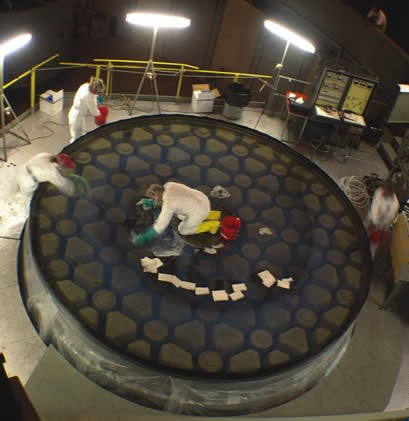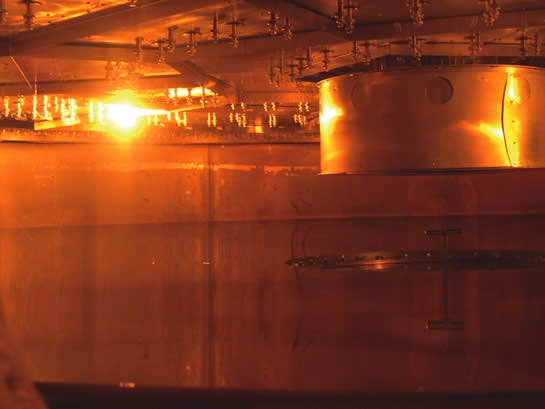Mirror, Mirror
Keeping the Hale Telescope optically sharp
Cleaning, stripping, vacuum metallizing—many of you work in plants that perform these processes on an industrial basis every day. You may not give much thought to many of the workpieces you process, production of some of which may number in the thousands per day.
But what if your workpiece was a 15-ton, 200-inch diameter mirror for the largest telescope at one of the world’s most famous astronomical observatories?
That’s the situation for workers at the California Institute of Technology’s Palomar Observatory in San Diego County, CA. Fortunately, complete stripping and refurbishing of the mirror that lies at the heart of the Hale Reflecting Telescope is a task they deal with only every 18 months to two years.
Sheer size is not the only challenge associated with such a workpiece—there’s also the minor issue of maintaining the mirror’s optical properties as perfectly as possible. Here’s how they do it.
Why Clean?
You might think the Hale mirror, nestled deep inside the telescope workings in the Observatory dome, would be relatively sheltered from dirt and soils. But telescope mirrors get a lot of use, and the Hale Telescope is no exception. According to Palomar Observatory’s W. Scott Kardel, the 200-inch Hale Telescope at the Observatory is used an average of 300 nights per year. Even with weekly cleanings, mirrors periodically need to be given a new coat of reflective aluminum.
“Soils that may accumulate on the mirror include oils from the machinery,” Kardel explains. “We have motors driving the telescope workings that are more than 60 years old. Some of them are suspended above the primary mirror, because we also use smaller mirrors that have to be moved in and out of position. Occasionally, one of the motors might leak. Oil may come from elsewhere, too.”
Other possible soils include occasional drops of rain or condensation, which leave water spots. “A water spot with a bit of dust or ash from a fire, for example, can actually form an acid eventually,” Kardel says. Obviously, that’s not acceptable on a surface that needs to be as optically perfect as possible.
To combat routine soil accumulations, observatory staff perform a weekly carbon dioxide dusting of the mirror surface. But even this will not remove water spots.
Eventually, the mirror surface degrades to a point where full refurbishment, including cleaning, stripping of the old vacuum metallized aluminum coating, and recoating becomes necessary. “On a historical basis, we’ve done the full stripping, cleaning and re-metallizing about every 18 months to two years,” says Bruce Baker, skilled trades senior at the Observatory. “Of course, some of that is contingent on scheduling of the telescope and how it’s being used.”
Prep Work
All work for mirror refurbishing is done inside the Observatory dome, without a clean room and, for metallizing, using a vacuum chamber that dates back more than 60 years to the Observatory’s inception.
First, the astronomical instrument located at the bottom of the telescope must be removed. The instrument cage and all wiring are also removed from the telescope, exposing the mirror cell that holds the 200-inch mirror to the telescope.
Observatory staff push a large cart to a position directly under the telescope. A platform on the cart is lifted up to catch the mirror cell, which is then unbolted from the telescope. The mirror cell is lowered and the cart with the mirror cell and mirror is then pushed away from the telescope on tracks to a position in the dome where it can be worked on.
Dams are set up around the perimeter to catch any water or other fluids used during cleaning and stripping. “We have to be very careful not to get water up under the mirror, because there’s a back support system there that holds the mirror,” explains Baker.
After inspection, the mirror receives an initial cleaning using soap and water applied with a hose, buckets and natural sponges. “The water is filtered tap water,” Baker say. “Obviously, we make sure there’s no shell or other foreign material in the sponges, and we really don’t scrub—it’s more of a patting motion. You lightly pat, then dip the sponge back in the bucket with the soap solution and keep working it.”
It’s important not to scrub or place too much pressure on the mirror surface, Baker explains, because either could impact the glass surface and thus its optical properties. “The only time we’d ever use a scrubbing motion is during the next phase of cleaning,, and for that we use disposable rags,” he says.
No heat is used during the process, either, and that can present a challenge for Observatory staff doing the work, according to Kardel.
“Temperatures on the mountain can get quite cold,” he says. “If we’re going to refurbish the mirror, it’s preferable to do it during the summer. But there’s a trade-off between the comfort of the staff doing the procedure and the likelihood of clouds. We’re more likely to have clouds during the winter, but that’s the most miserable time to work on the mirror for the staff. Everyone’s happier if you can do it when it’s warmer.”
‘Green River’
Once initial cleaning is complete, Observatory staff prepare to strip the old aluminized coating. For this, they use an acid solution called “green river.”
“Green river is a name that someone came up with many years ago for the solution we use to strip the old aluminum coating,” Baker says. “The basic formula for green river is two quarts of distilled water, one quart hydrochloric acid and one ounce of cupric sulfate.
“We flood the mirror surface with the green river solution,” he continues. “The entire surface is done at once. After five or ten minutes, you can see the thin coating of aluminum begin to lift off the glass surface.”
Staff are stationed at various locations around the mirror during stripping to monitor the process and assure that the entire surface remains wet at all times. “We don’t ever want any liquid, and that includes water, to dry on the mirror,” Baker explains. “That would result in a spot, and if we have a spot on there we’ll see it when we aluminize.”
Green river strips the aluminum from the mirror surface, revealing the complex core structure of the mirror’s underside that reduces its weight and provides locations to mount the support structure.
At this point, the glass surface is ready for final cleaning and preparation using an alkaline cleaning procedure consisting of potassium hydroxide followed by calcium carbonate. “Once the aluminum is off the mirror, we want to really clean the glass surface,” Baker explains. “We may also use a nitric acid solution on it if needed.”
Final cleaning is followed by a thorough tap water rinse and a distilled water rinse before workers use pure ethanol to wipe the surface down.
Vacuum Metallizing
At this point the mirror is ready for re-coating, but getting it together with the vacuum chamber used for metallizing is one of the more delicate portions of the entire refurbishing operation.
A crane operator at the top of the dome carefully lifts the 17.5-ton vacuum chamber over the top of the 200-inch mirror. The chamber is lowered over the mirror and secured to the cart. Pump-down to eliminate all air from the chamber takes about a day.
The same vacuum chamber has been used for metallizing since the observatory opened. “The mirror was originally aluminized using a pro
There are other mirror metallizing systems in use, he adds. “I recently visited an observatory in Arizona where they aluminized the mirror without disassembling the telescope. They lowered a “boat” containing the aluminum metal into the vertical telescope, and the system had a sensor that monitors coating development and shuts off the flow when it reaches the required thickness.”
The Hale Telescope’s metallizing apparatus has no “boat” or monitoring system. Instead, it relies on 350 tungsten filaments distributed over the vacuum chamber ceiling to lay down a coating of commercially pure aluminum with nominal thickness of 8 Å (that’s 0.0008 μm.)
To maintain even coating thickness over the mirror surface, Baker cuts a precise length of 0.025-inch diameter aluminum wire for each filament. “It’s all hand-done,” he explains. “I cut lengths of wire off the roll, and as I go I occasionally check the weight of a sample to make sure it’s OK. Each wire should weigh 0.27 g. I then make loops of wire, hang them on the tungsten filaments and melt them into the filaments. The process takes several days to complete.”
Once all prep work is completed, metallizing is not much different than an industrial vacuum metallizing process. The tungsten coils are electrified in a specified sequence, heating them to temperatures of more than 1,000°F. The aluminum vaporizes and coats everything in the chamber with a thin, shiny film.
Precise process control is crucial to maintaining the optical properties of the mirror, and Observatory personnel monitor coating thickness using test slides on the massive workpiece. “We also perform a series of tests on the mirror for scatter and reflectivity before we re-install it,” Baker says. “It’s a bit difficult to get at once it’s back in the telescope.”
cess developed by CalTech physicist and astronomer John Strong in the late 1930s,” Kardel says. “While the observatory for the Hale Telescope was being constructed, Strong invented the process and first applied it to the mirror on the 100-inch telescope at the Mt. Wilson Observatory.” Prior to vacuum metallizing to produce a thin layer of pure aluminum, mirrors were literally “silvered” using a silver nitrate chemical technique, Kardel adds.
Despite being more than 60 years old, the process developed by Strong works well for the Hale Telescope, Baker says. A similar process is used for the Palomar Observatory’s three other mirrors that require periodic refurbishing. “Technologies in the vacuum world have evolved, obviously. There have been some improvements in, for example, vacuum pumps, and there’s been some mild tweaking of the process, but for the most part it’s the standard system we’ve used since the observatory opened,” Baker says.
Read Next
Delivering Increased Benefits to Greenhouse Films
Baystar's Borstar technology is helping customers deliver better, more reliable production methods to greenhouse agriculture.
Read MoreEpisode 45: An Interview with Chandler Mancuso, MacDermid Envio Solutions
Chandler Mancuso, technical director with MacDermid Envio discusses updating your wastewater treatment system and implementing materials recycling solutions to increase efficiencies, control costs and reduce environmental impact.
Read MoreEducation Bringing Cleaning to Machining
Debuting new speakers and cleaning technology content during this half-day workshop co-located with IMTS 2024.
Read More











.jpg;maxWidth=300;quality=90)










